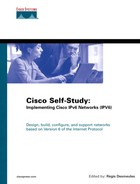Mobile IP
The Mobile IP protocol is designed to allow network nodes to maintain their IP connectivity with remote nodes while moving from one point of attachment to another. The Mobile IP protocol is mostly designed for wireless devices, although it can be used with any wired technology.
Mobile IPv6
The Mobile IPv6 protocol has important design changes compared to Mobile IPv4:
Foreign agent— Mobile IPv6 has no foreign agent, because each mobile IPv6 node can handle the mobility. However, the home agent is still mandatory in IPv6.
Internet nodes— Any compliant IPv6 node has mobility support built in. This is not the case in IPv4, because the Mobile IPv4 support is an addition to the IPv4 protocol.
Registration— UDP on port 434, used in IPv4 to exchange messages between the mobile nodes and the agents, is replaced by the use of the Destination extension header in IPv6.
Packet delivery— The first packet delivered to the mobile node by its home agent is sent through an IPv6-in-IPv6 tunnel. But subsequent packets exchanged between the mobile node and any Internet nodes use the Routing extension header. This is much more efficient for the exchange of packets between the mobile and correspondent nodes than passing all packets through the home agent, such with Mobile IPv4.
In conclusion, Mobile IPv6 is much more efficient than Mobile IPv4 in many aspects.
NOTE
The Mobile IPv6 specification work is not yet complete at the IETF.
